

Requirements
- Planning Your Trip
- Entry Requirements
Welcome to Costa Rica!
Requirements to enter the country.
Entry to Costa Rica has been opened to tourists from all countries.
All tourists must comply with the immigration processes established in the General Immigration and Aliens Act (Ley General de Migración y Extrangería).
During your visit in Costa Rica, you are required to comply with the health protocols put in place by private companies when participating in any tourism activities in the country.
In accordance with Article 42 of the General Law on Immigration and Aliens (No. 8764) and Article 30 of the Immigration Control Regulation (Executive Decree No. 36769-G), foreign nationals intending to enter Costa Rica must provide:
- A valid passport or travel document. Passports and travel documents will only be accepted if they can be read electronically in line with the guidelines established by the International Civil Aviation Organization (ICAO) and must be valid for the period set forth in these guidelines.
- Visa, if required under these guidelines.
- Proof of economic means, with a minimum of US$100.00 (one hundred US dollars) per month or partial month of legal stay in the country.
- Return ticket to the country of origin or plan of onward travel that includes the next destination.
- No impediment to entering Costa Rican territory.
MAXIMUM STAY:
The maximum legal stay for foreign nationals will be determined by the immigration agent upon their entry into the country.
Countries in the first group: UP TO 180 CALENDAR DAYS, NON-EXTENDABLE
Countries in the second group: UP TO 30 CALENDAR DAYS
Countries in the third group: UP TO 30 CALENDAR DAYS, EXTENDABLE
Countries in the fourth group: UP TO 30 CALENDAR DAYS, EXTENDABLE
Please remember:
- In order to enter Costa Rica, you will need a ticket for a return flight, which the immigration official will ask to see when you arrive. It is recommended that you make a photocopy of your passport with the entry stamp, which you should carry with you at all times during your stay.
- The number of days you are permitted to stay in Costa Rica will depend on the group your country of origin belongs to.
- The immigration official may ask you to demonstrate that you have the funds needed for your stay in the country.
- The immigration official may indicate in your passport that your permitted stay will be for a different amount of time.
- Visitors to Costa Rica must have a valid passport and proof that they will be leaving the country before their visa or entry stamp expires.
All travelers must therefore have a ticket for return or onward travel.
Non-residents must have a ticket for return or onward travel if they:
Are arriving on a one-way ticket.
Are entering the country with a return ticket that is more than 90 days after their date of arrival.
Are flying to Costa Rica and flying out of a different country.
By law, a return or onward travel ticket may be on one of the following means of approved commercial transportation:
- A pre-purchased bus ticket out of the country.
- A pre-purchased flight out of the country.
- Proof of passage on a cruise ship.
Obligatory declarations when entering or leaving Costa Rica:
When entering or leaving a port of entry to Costa Rica, if you are carrying an amount equal to or greater than US$10,000 in cash or securities, or its equivalent in other currencies, you must request and complete the form designated for this purpose in the immigration checkpoint and present it to the Customs Authority for verification. The declaration must be made before finalizing the corresponding immigration procedures.
Failure to follow the provisions of Costa Rican law (No. 8204, Article 35) will result in the immediate forfeiture of the money.
What kind of vaccines do visitors to Costa Rica need?
As of July 30, 2007, Costa Rican authorities require all travelers from the following countries to have a certificate of vaccination against yellow fever: Angola, Benin, Burkina Faso, Cameroon, the Democratic Republic of Congo, Gabon, The Gambia, Guinea, Liberia, Nigeria, Sierra Leone, Sudan, Bolivia, Venezuela, Brazil, Peru, Colombia and Ecuador, as well as the Republic of Guyana.
If you need more information, please click here
* By clicking on ‘ click here ’ you will leave visitcostarica.com and will be redirected to another website *
Planning your Trip to Costa Rica
Suggested itineraries
Accommodations
Restaurants
Other Activities
Local Travel Agencies
Travel Tips
#EssentialCostaRica
Share your experience, .


Raymond Forbes Photography / Stocksy United

Centering yourself on a surfboard or yoga mat, descending into bat-filled caves or ascending misty volcanic peaks – relax and enjoy the ride of Costa Rica.
Best Time to Visit
Best places to visit, attractions, must-see attractions.
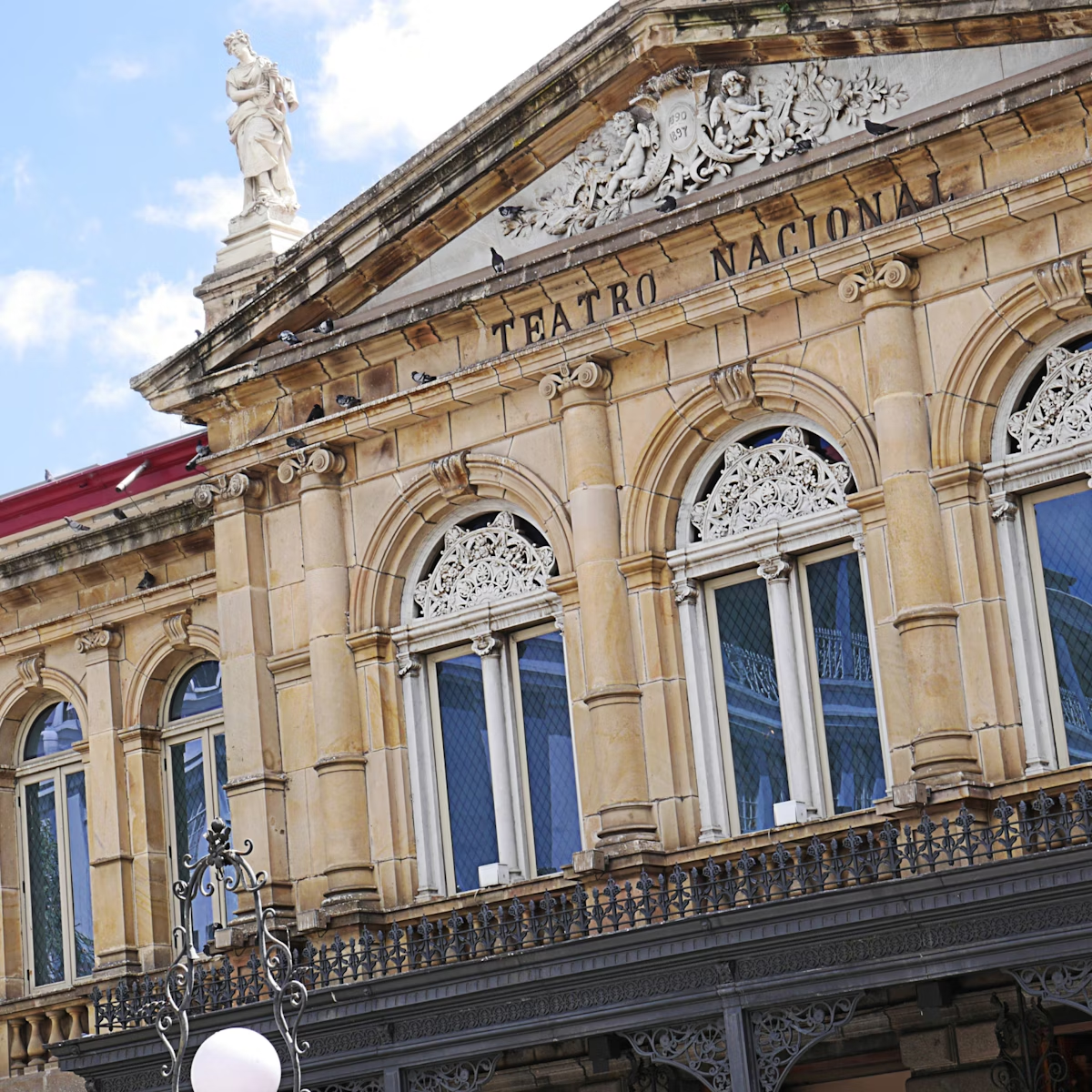
Teatro Nacional
On the southern side of the Plaza de la Cultura resides the Teatro Nacional, San José’s most revered building. Constructed in 1897, it features a columned…

Parque Nacional Manuel Antonio
Parque Nacional Manuel Antonio & Around
Featuring lush jungle, picture-perfect beaches and craggy headlands, this tiny park (1680 acres/680 hectares) absolutely brims with wildlife (and often…
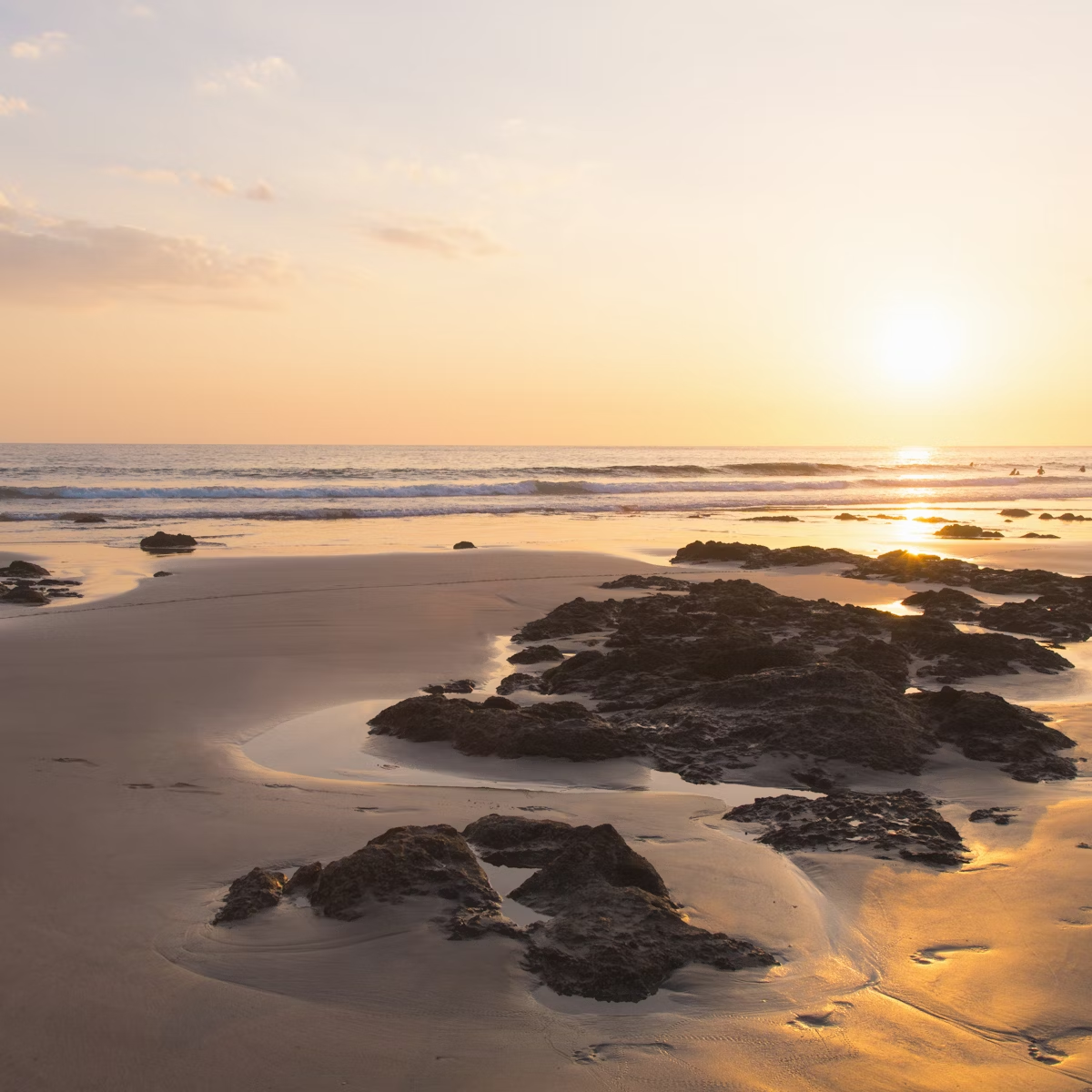
Playa Negra
At the northwestern end of Cahuita, Playa Negra is a long, black-sand beach flying the bandera azul ecológica, a flag that indicates that the beach is…

Parque Nacional Isla del Coco
Southern Costa Rica & Península de Osa
Around 500km southwest of the Costa Rica mainland, Isla del Coco is a natural wonder that teems with wildlife, including the largest schools of hammerhead…

Parque Nacional Volcán Arenal
From 1968 until 2010, Volcán Arenal was an ever-active and awe-striking natural wonder, producing menacing ash columns, massive explosions and streams of…
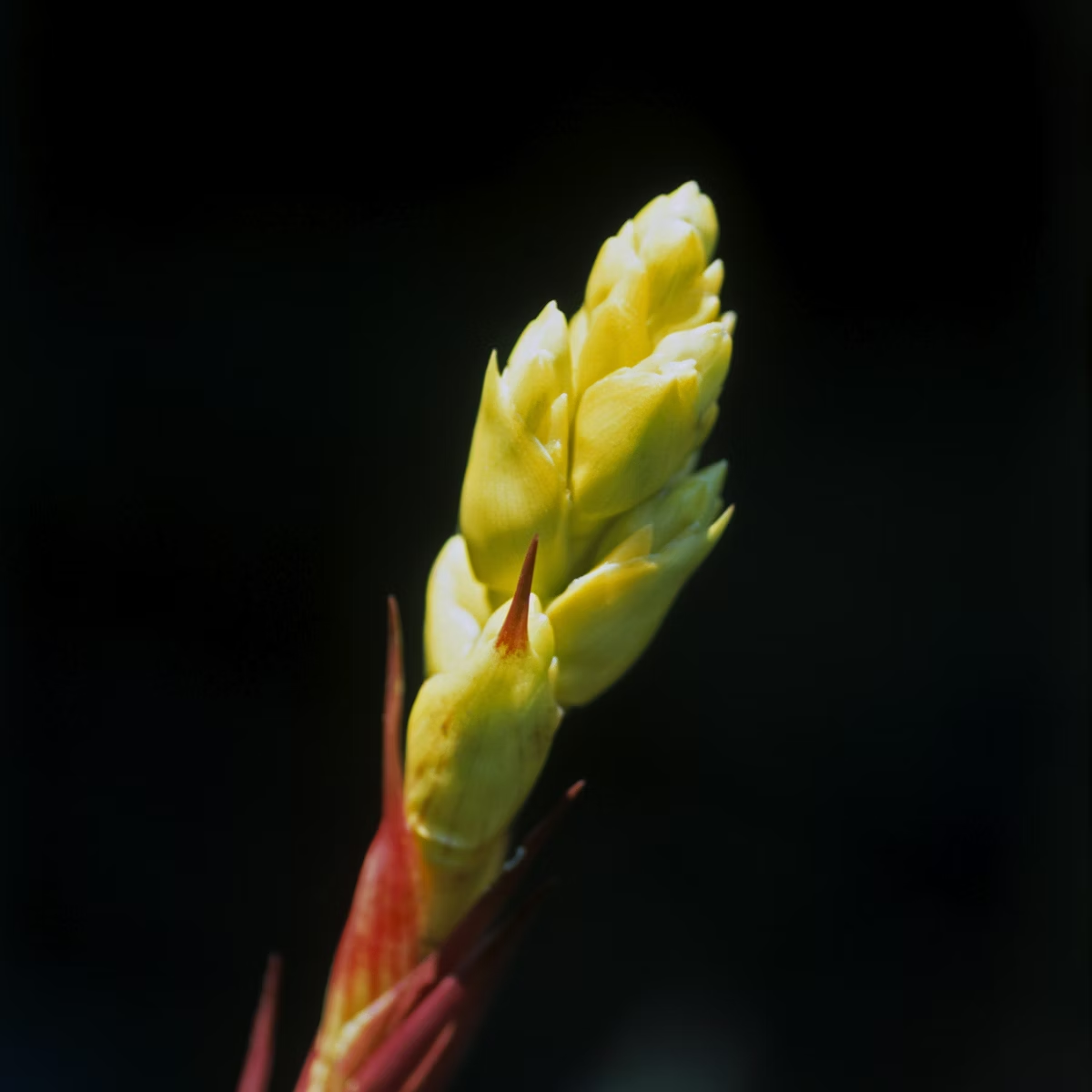
Wilson Botanical Garden
The world-class Wilson Botanical Garden is internationally known for its collection of more than 2000 native Costa Rican species. Species threatened with…
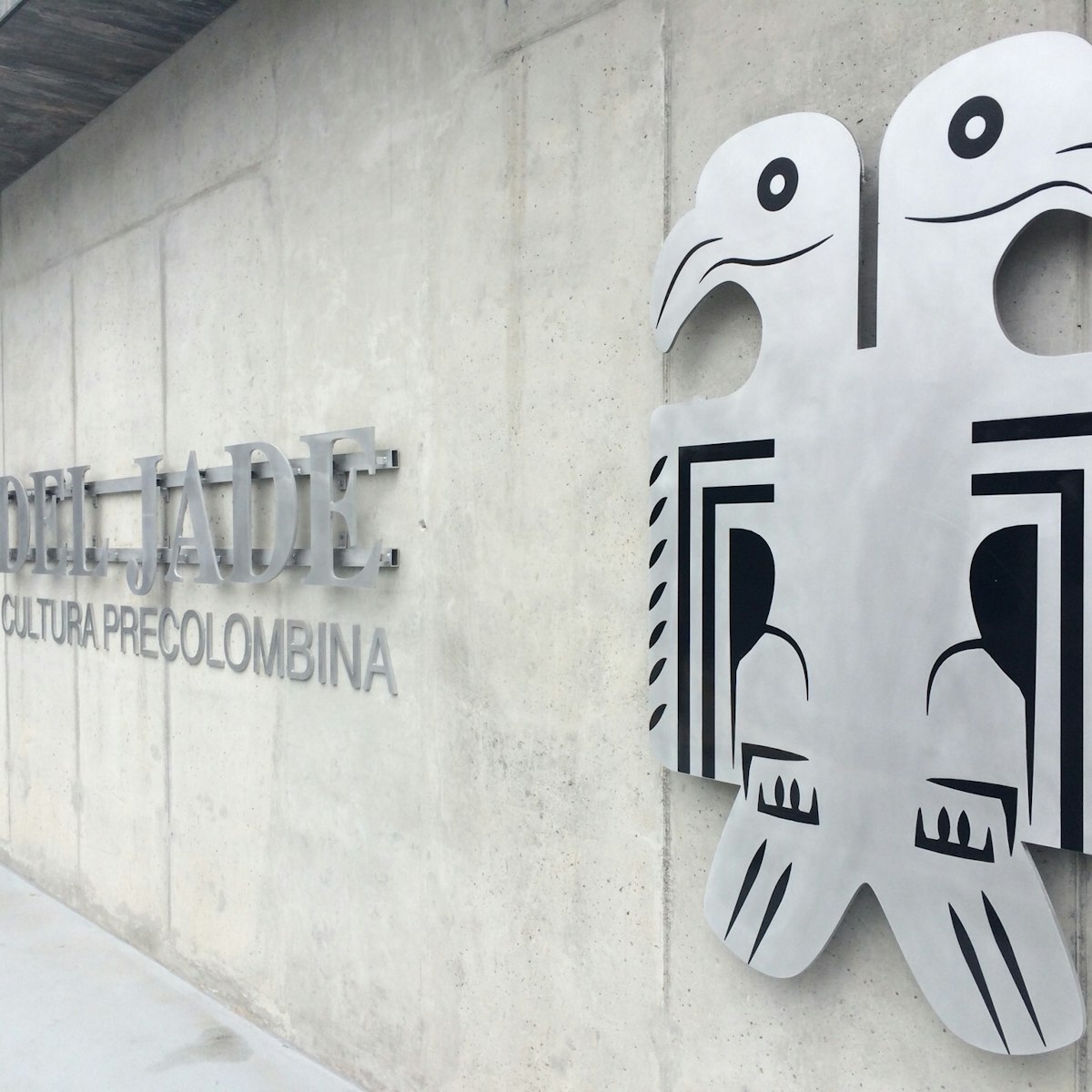
Museo del Jade
This museum houses the world’s largest collection of American jade (pronounced ‘ha-day’ in Spanish), with an ample exhibition space of five floors…

Punta Catedral
Geography fun fact: this isthmus, which is the centerpiece of the park, is called a tombolo and was formed by the accumulation of sand between the…
Planning Tools
Expert guidance to help you plan your trip.
Best Things to Do
From water sports and mountain hikes to rainforest wildlife watching and cloud-forest birding, these are the best things to do in Costa Rica.
Things to Know
Adrenaline-pumping activities, pristine beaches, dense rainforests, Costa Rica has it all. Here's what you need to know before you go.
Transportation
Find out the best way to get from A to B in Costa Rica, whether your budget and schedule stretches to bus, boat, rental car or airplane.
Visa Requirements
Costa Rica is a stunning country that's beloved by travelers. Here's everything you need to know about its entry requirements before you go.
Money and Costs
There are plenty of ways for cost-conscious travelers to save some colones. Here are 10 top tips for traveling on a small budget in Costa Rica.
Traveling with Kids
Costa Rica is the easy way to dive into Central America with kids in tow. Here are our top family adventures, from surf beaches to volcano hikes.
Best Road Trips
Experience the best of Costa Rica with these top road-trip routes.
Plan with a local
Experience the real Costa Rica
Let a local expert craft your dream trip.
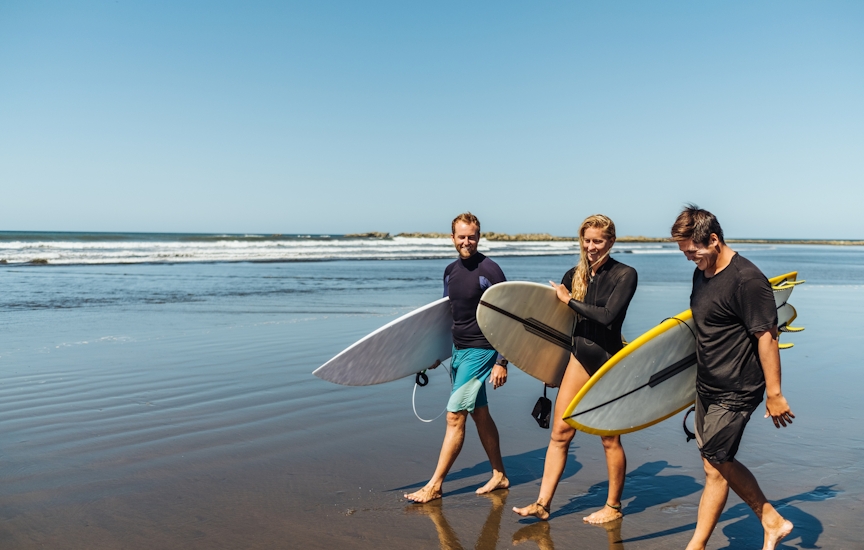
Latest stories from Costa Rica
Filter by interest:
- All Interests
- Adventure Travel
- Art & Culture
- Beaches, Coasts & Islands
- Food & Drink

Tips & Advice
Oct 2, 2024 • 21 min read
Next stop, Costa Rica! An expert's guide on maximizing your points & miles for the ultimate Costa Rica getaway in 2024.

Aug 29, 2024 • 6 min read
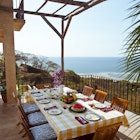
Aug 16, 2024 • 5 min read

Aug 5, 2024 • 6 min read

Aug 5, 2024 • 7 min read
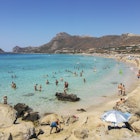
Jul 23, 2024 • 9 min read

Jul 3, 2024 • 6 min read

Jul 2, 2024 • 5 min read
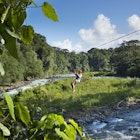
Jun 27, 2024 • 9 min read

Jun 26, 2024 • 3 min read
in partnership with getyourguide
Book popular activities in Costa Rica
Costa rica and beyond.


Costa Rica Unveiled: The 15 Best Places to Visit for First-Timers in 2024
By Author Steph Dyson
Posted on Last updated: 30th January 2024
Few countries in the world can compare with Costa Rica. Hosting an abundance of tropical rainforests, picture-perfect beaches, and an incredible abundance of wildlife, this is a truly remarkable country and one that’s increasingly popular with adventure travelers.
Best of all, Costa Rica is consistently ranked as the safest place in Latin America according to the Global Peace Index . Home to six percent of the world’s biodiversity and with 28 percent of its land protected – one of the largest numbers in the world – Costa Rica’s green credentials are nothing short of remarkable.
It’s this unspoiled nature, combined with its consistently excellent surf, active volcanoes, and accessible hiking trails that are behind the country’s appeal.
And that’s even before we mention the incredibly welcoming local people. Known as Ticos, Costa Ricans are known for their cheerful approach to life, aka “pura vida” (pure life). Their hospitality and friendliness are second to none.
But where in this vast country should you go on your first trip to Costa Rica? It was hard to whittle the destinations down, but this list comes from the month I spent exploring the far reaches of the country – and discovering the very best it has to offer.
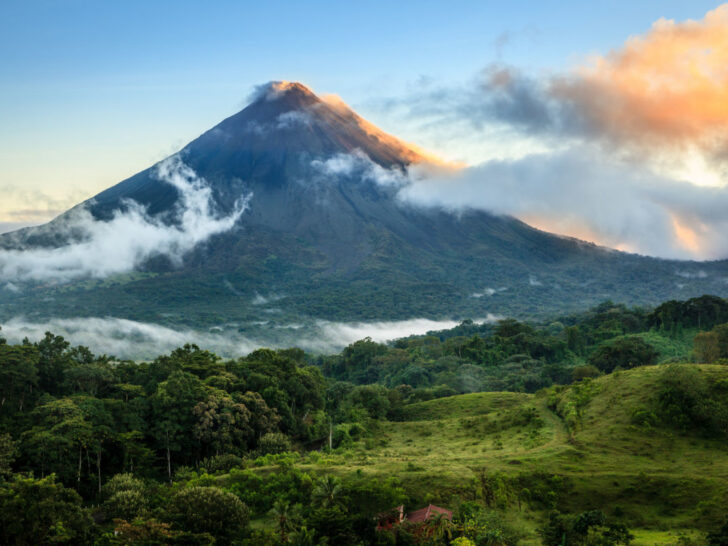
So, whether you’re looking for culture, to summit an active volcano, or to encounter some of Central America’s rarest wildlife, here’s my guide to the best places to visit in Costa Rica.
Click to navigate this article:
1. San José
- Why it’s great for first-timers: San José serves as the economic heart of Costa Rica and, while it doesn’t quite have the same cultural richness as other capitals such as Buenos Aires, Santiago, or Lima, it’s an introduction to the country’s history and urban life.
You’ll likely have at least a day in the Costa Rican capital before heading out into the backcountry. With just over 340,000 residents, San José is decidedly low-key, but there’s still plenty to do here.
Start with the capital’s handful of worthwhile museums, including the indigenous gold at the Museo de Oro Precolombino , before heading to the brilliant Museo del Jade , which houses the largest collection of jade in the Americas.
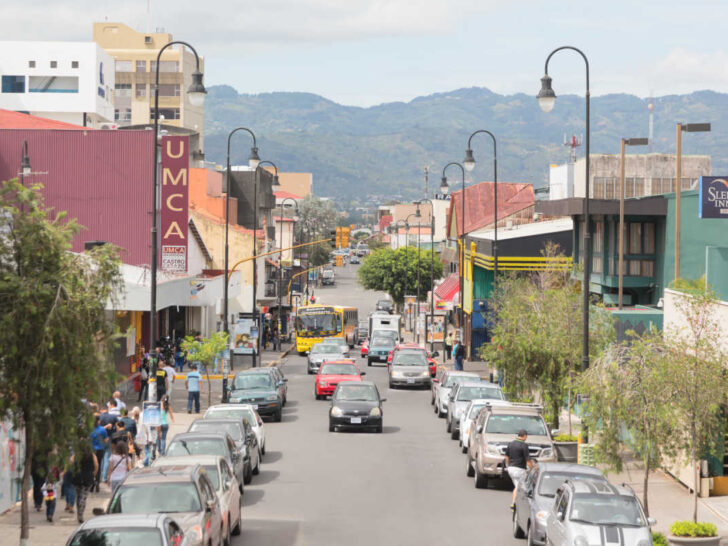
There’s nothing quite like a Central American market for a shock to the senses, so take a wander around the Central Market and try a traditional Costa Rican breakfast or lunch of gallo pinto (red and white beans with scrambled eggs) in one of the many traditional sodas (family-run restaurants) that dot the city.
Alternatively, head to Sikwa Restaurante , which is considered Costa Rica’s best , for a fancy take on indigenous recipes.
Where to stay in San José
I stayed in a handful of different hotels in the capital, and found the best were the family-run B&Bs, such as Casa 69 San José ($78 USD double), or, if you’ve got a bigger budget and fancy pool access, Studio Hotel Boutique ($118 USD double).
How to get to San José
Fly into Juan Santamaría International Airport (SJO), located just outside San José, and take an Uber (around $11.5 USD; 20 mins) or shuttle ride ($1 USD; 35 mins) into the city. Uber is very safe and inexpensive in the city.
2. The Osa Peninsula
- Why it’s great for first-timers: When it comes to flora and fauna, nowhere on the planet compares with the Osa Peninsula; it’s home to a remarkable 2.5% of the world’s biodiversity . Your chance of spotting some pretty rare wildlife is exceptionally high here, making it easily one of the best places to visit in Costa Rica.
Corcovado National Park (Parque Nacional Corcovado) lies at the very heart of the Osa Peninsula and is the place to spot everything from four species of monkeys to puma, tapir, sloths, and other rare beasts.
Hiking trails crisscross its 424 square kilometers (161 sq miles), allowing you to wander through thick jungle with the calls of toucans and spider monkeys interspersed with the roar of the waves beyond.
The remotest part of the park is Sirena Ranger Station – although, as it’s only accessible by a lengthy hiking trail or one-hour boat journey, you’ll pay a pretty penny to get there.
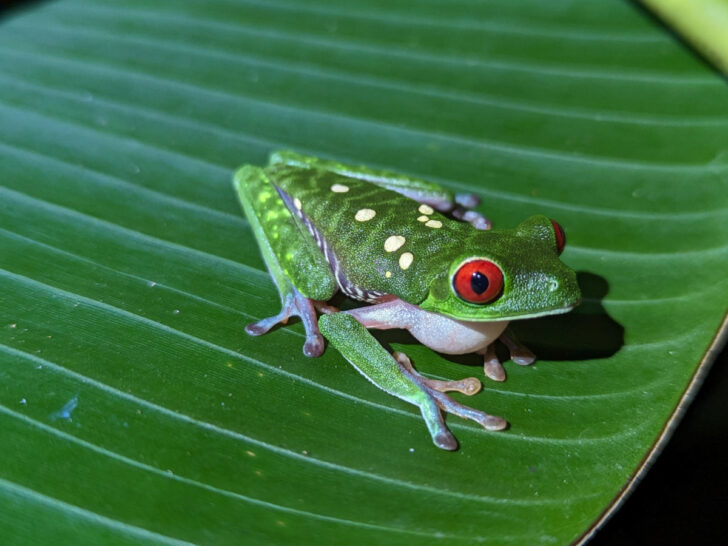
Dolphin and whale watching tours are also popular activities to do from the Osa Peninsula. I headed out on a boat to the Isla del Caño Biological Reserve (Isla del Caño Reserva Biológica), a tiny island whose protected waters are lined with coral and teeming with phosphorescent fish, dolphins, and leatherback turtles.
Hotels in the far south of the peninsula are another brilliant option for both wildlife and relaxation.
El Remanso , a luxury lodge with outstanding sea views, beautiful cabins with plunge pools, and exceptional food, was surrounded by its own slice of preserved rainforest, and I actually saw more wildlife there than in the national park itself.
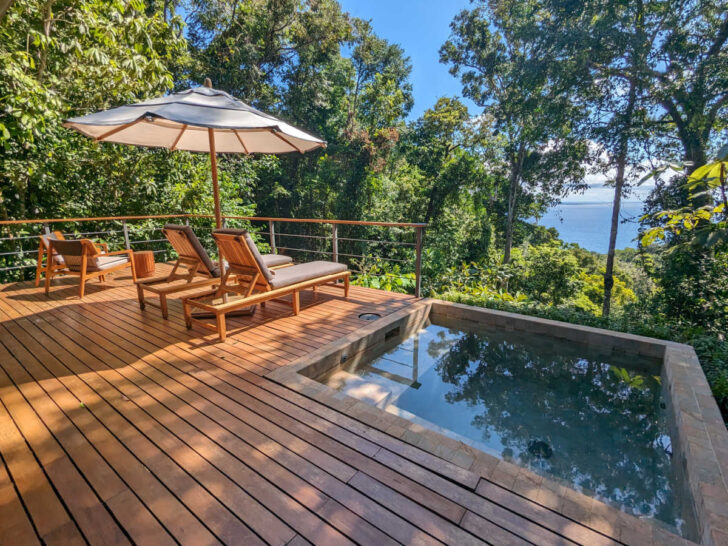
If you’re after a relaxed but wildlife-filled trip, this is one of the best vacation spots in Costa Rica.
Where to stay in the Osa Peninsula
The most affordable means of visiting Corcovado National Park is staying in one of the many hostels and hotels in nearby Drake Bay, which lies a short drive north of the park. However, if you’ve got the cash, consider a few nights at SCP Corcovado ($1,025 USD double all-inclusive, two-night minimum), a plush hotel that sits right on the park’s boundaries and far from any other habitation – allowing for direct contact with some pretty surprising wildlife, including tapirs and the hotel’s resident puma family.
However, by far my favorite hotel of the entire trip was El Remanso Rainforest Lodge ($800 USD double, all-inclusive, two-night minimum) in the far south of the Osa Peninsula. Not only did I see all four monkey species found here – howlers, white-faced capuchin, spider, and squirrel – but I spotted an armadillo, collared anteater, and, potentially, a kinkajou. It was a truly magical place.
How to get to the Osa Peninsula
To reach the north of the peninsula, I traveled overland from Uvita and then by motorboat from Sierpe through the mangroves. However, the most scenic way is by aircraft from San José to either Drake Bay airport or Puerto Jiménez if you’re staying in the south of the peninsula. The views of the peninsula from above are truly breathtaking.
3. Monteverde
- Why it’s great for first-timers: Monteverde’s cloud forests are just that: forests embraced by thick clouds. Rich in flora and fauna – such as the iconic resplendent quetzal – the area is both cooler (and wetter) than other parts of Costa Rica but still absolutely magical.
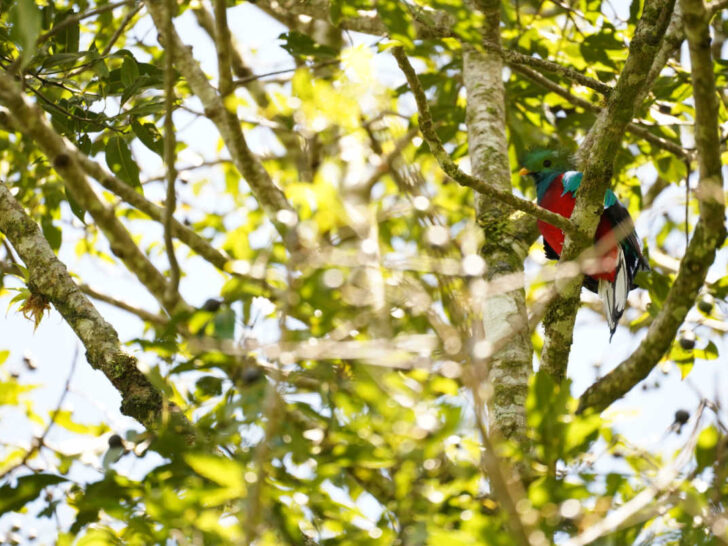
The star attraction in this region is the Monteverde Cloud Forest Reserve (Reserva Biológica Bosque Nuboso Monteverde), a tract of primary cloud forest with hiking trails, viewpoints, canopy tours, and hanging bridges.
The appeal lies, like much of Costa Rica, in the fact it’s crammed full of a stupendous amount of flora and fauna: 3,000 plant species, 100 types of mammal, and over 400 species of bird. Because it’s considered one of the best places to go in Costa Rica, the reserve does get packed with tourists.
I highly recommend instead the Santa Elena Cloud Forest Reserve (Reserva Bosque Nuboso Santa Elena) for a quieter hiking experience through the magical cloud forest.
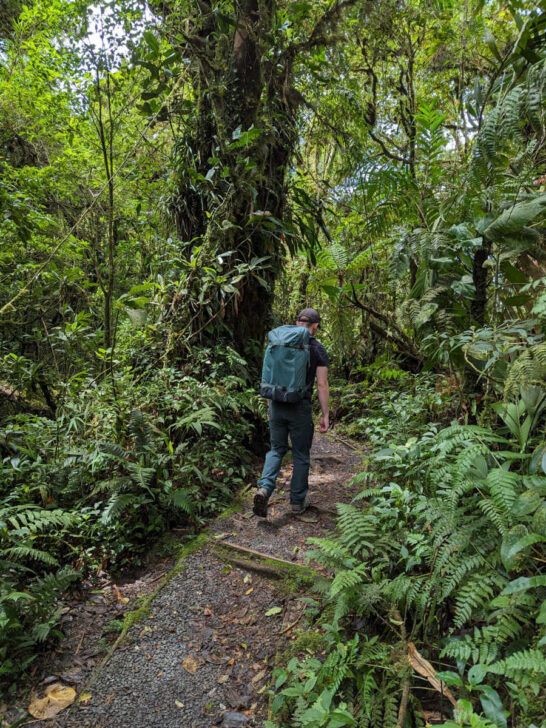
Both reserves, and the new Curi-Cancha Reserve (Reserva Curi-Cancha), are good places to spot the resplendent quetzal, an iconic – and magnificent – Costa Rican bird.
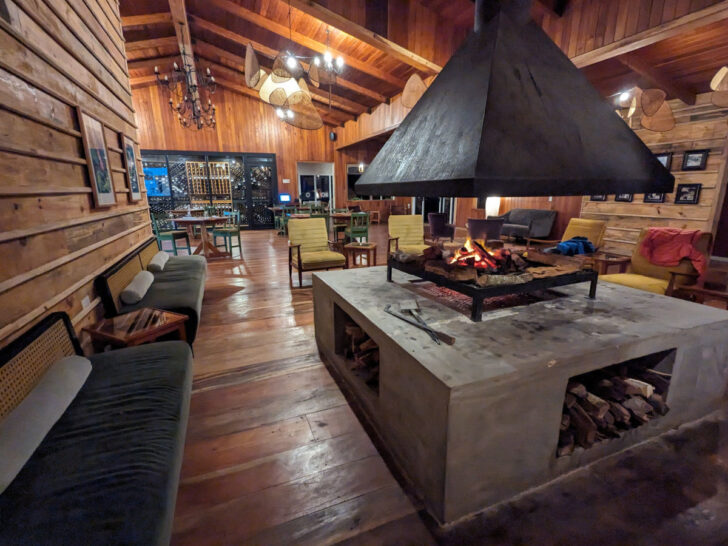
Where to stay in Monteverde
Santa Elena is home to the lion’s share of lodgings and is a short drive from all of the reserves. I stayed at Cloud Forest Lodge ($332 USD double) however, I found the downstairs suites overpriced and dingy, although the views from the restaurant and bar across the forest were spectacular.
Instead, l would highly recommend Hidden Canopy Treehouses ($329 USD double), a boutique hotel whose six treehouses sit high up in the treetops for direct views of the surrounding wildlife. The hospitality is second to none, too.
How to get to Monteverde
To reach Santa Elena, the road from San José is in poor condition and extremely windy but still passable. Many tourists take a shuttle from the capital city, but, if you’re traveling in a couple or group, a hire car is a more affordable option. Alternatively, you can fly into the nearby Daniel Oduber Quirós International Airport, just outside of Liberia in Guanacaste (45 mins), and take a shuttle or car to Santa Elen
4. The Pacuare River
- Why it’s great for first-timers: Carving its way through a steep canyon fringed with primary rainforest, the Pacuare River is considered one of the best places on the planet for white water rafting and feels far deliciously from civilization.
While it’s possible to spend just a day whitewater rafting down the Pacuare River, this magical slice of jungle and tumbling water merits more of your time.
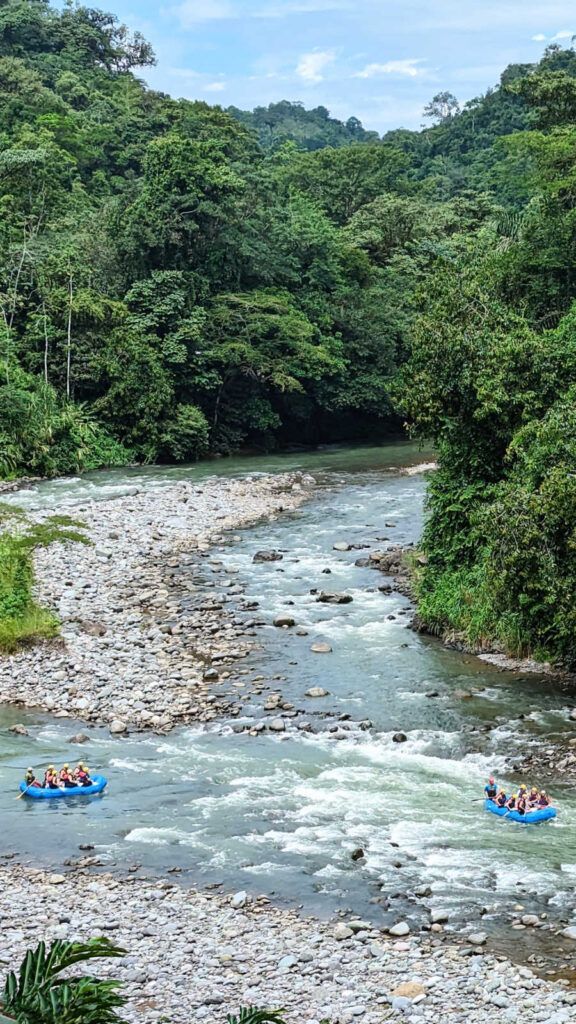
Get a 10% discount off a trip to the Pacuare River
Rios Lodge is one of the leading eco lodges along the Pacuare River and has helped drive the sustainability efforts that have protected the surrounding jungle.
The team of rafting guides are brilliant, the views from bedrooms across the river mesmorizing, and the food some of the best I ate in Costa Rica.
They’re offering a 10% discount on the price of the lodge for all Worldly Adventurer readers. Just use the code wa10 when booking.
Practically all of the lodges on the Pacuare River can only be reached and left by one means: rafting and it’s something you should definitely add to your list of Costa Rica vacation activities.
But it’s a thrill to bounce through Class I to V rapids as the raft takes you past astoundingly beautiful scenery as monkeys and kingfishers watch from above and otters plunge in the water below.
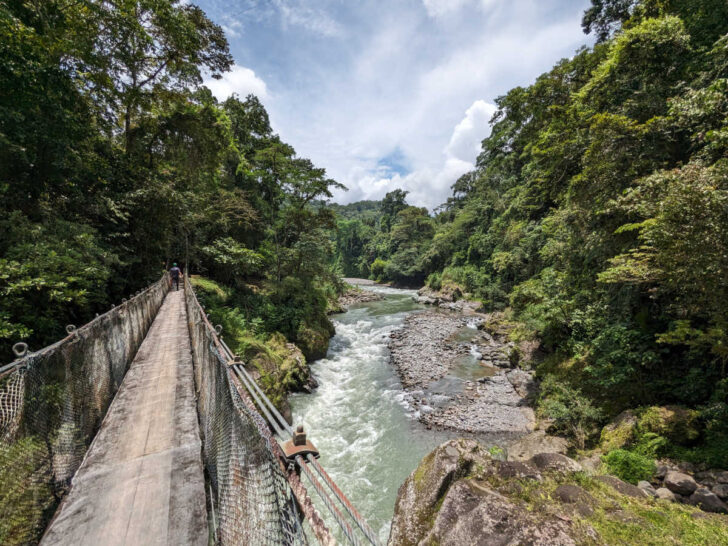
Once in a lodge here, you can enjoy everything from tubing to day hikes to waterfalls, enjoying the lodge’s incredible zipline, which passes across the river eight times with stupendous views as you speed through the treetops, or just listening to the roar of the river as you kick back in a hammock.
The Pacuare River is not just an adrenaline-pumping adventure but also an opportunity to witness a slice of absolute heaven in one of Costa Rica’s wildest corners.
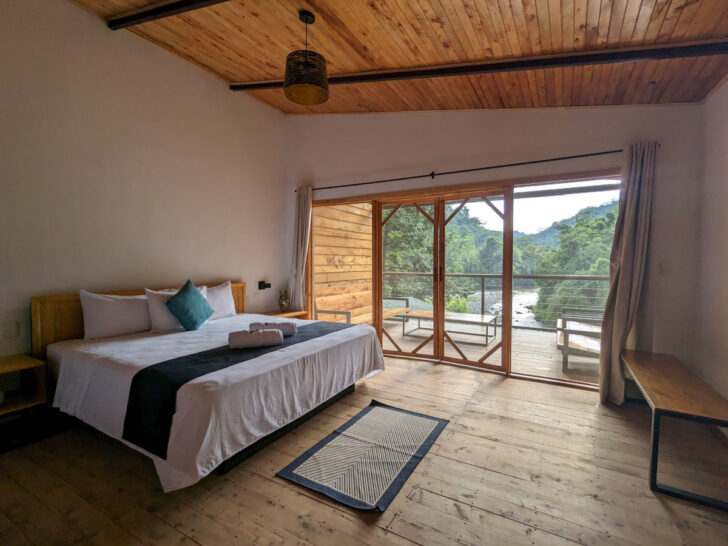
Where to stay at the Pacuare River
I stayed at Rios Lodge (from $925 USD double all-inclusive for two nights; $50 USD pp dorm per night), a beautiful hotel that has historically been a pioneer in conservation in the region. Fully powered by green energy and working to reforest cleared land in the locality, this lodge sits right on the river, and the roar of the water will sing you to sleep at night. The food is brilliant, the rooms comfortable, and the staff outstanding, with additional activities including ziplining, tubing, waterfall hikes, and swimming in their natural rock pool. Fancy a 10% discount off your stay at Rios Lodge? Just use the code wa10 when booking.
How to get to the Pacuare River
Tour companies will pick you up from San José to the Pacuare River launch point, which lies a few miles north of most lodges.
- Why it’s great for first-timers: Located on Costa Rica’s South Pacific coast, Uvita is renowned for its white sand beaches, and proximity to Marino Ballena National Park, a feeding and breeding spot for migrating humpback whales.
Whether you’re a water baby or want to catch sight of some marine wildlife from a boat, the town of Uvita is the perfect place to kick back for a couple of days and tops my list of the best towns to visit in Costa Rica for first-timers.
Marino Ballena National Park (Parque Nacional Marino Ballena) covers more than 5,200 hectares (13,000 acres) of ocean and 14 kilometers (9 miles) of coastline and is where you hike to remote beaches, snorkel amongst rainbow-colored coral reefs, and motorboat through mangrove forests.
At low tide, take a wander to the “Whale’s Tail”, a sandbar in the shape of – yup, you’ve guessed it – a whale’s tail, although it’s most visible from the hotels in the hills above Uvita.
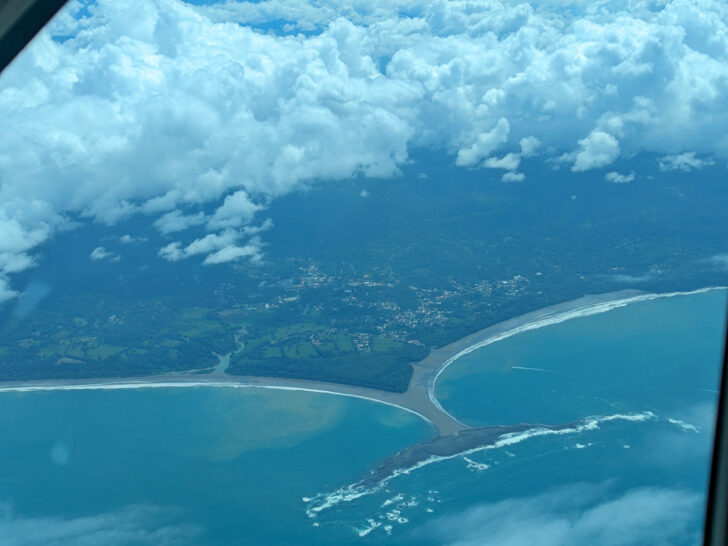
This is definitely one of the best areas to stay a few days in Costa Rica to sunbathe and swim, however, the real appeal for me was the opportunity to go whale watching.
Humpback whales flock to these waters between mid-July and the end of October; in a two-hour boat tour, we saw six groups of female whales with their offspring, plus bottlenosed dolphins, and hawksbill and olive ridley turtles.
The nearby town of Dominical is a great day trip from Uvita, where you’ll find surfing and paddleboarding, plus a hike to the stunning Nauyaca Waterfalls.
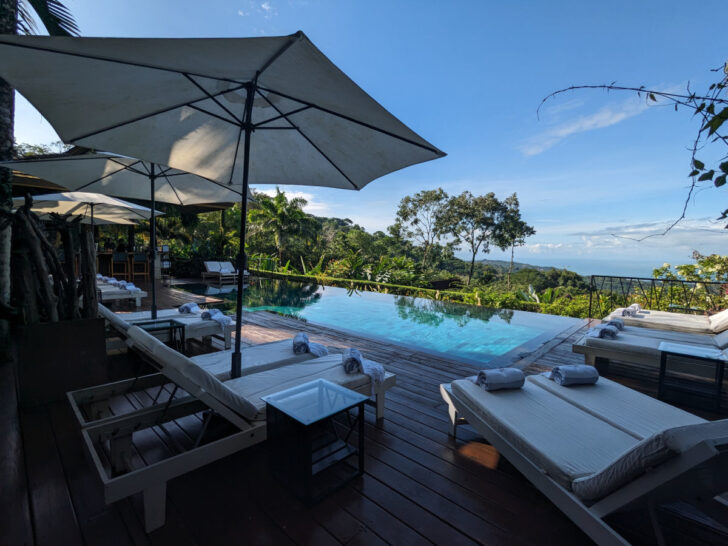
Where to stay in Uvita
I stayed at the beautiful Oxygen Jungle Villas ($530 USD double), a four-star hotel built into the foothills above Uvita. Their spacious cabins are extremely comfortable (and the aircon was welcome!), while the view of the ocean and watery sunsets from the restaurant and pool are divine. The food was some of the best I ate in Costa Rica, too.
There are plenty more affordable options, however, including the boutique Uvita Paradise ($140 USD double), which is just a stone’s throw from Playa Colonia and the Whale’s Tail.
How to get to Uvita
From San José, the quickest way to get here is by hire car or a tourist shuttle bus south along the Pacific Coast (approximately 4-5 hours). Alternatively, the local bus takes seven hours, and includes a toilet and snack break). Public transport can be one of the cheapest ways to get around Costa Rica, however, a rental car will give you a lot more flexibility.
If driving, consider stopping at Crocodile Bridge , about 1.5 hours from San Jose on Ruta 34 where you might spot – yes, you’ve guessed it – crocodiles in the river below!
6. Tortuguero National Park
- Why it’s great for first-timers: Tortuguero National Park lies on the Caribbean coast, and, while the sweltering heat takes a while to get used to, this remote Costa Rican enclave is one of the best places to see green sea turtles. It’s definitely one of the best places to visit on Costa Rica’s Caribbean side for wildlife.
The vast Tortuguero National Park (Parque Nacional Tortuguero), which protects over 1,270 square kilometers (490 sq miles), is one of the most important nesting sites in the world for leatherback, hawksbill, and green sea turtles.
Between March and May and July and October, you can watch them pull themselves up the beach and lay some 80 eggs each into the sand. Keep an eye out for jaguars here, too; they’re easiest to spot in this area because of their love of turtle meat!
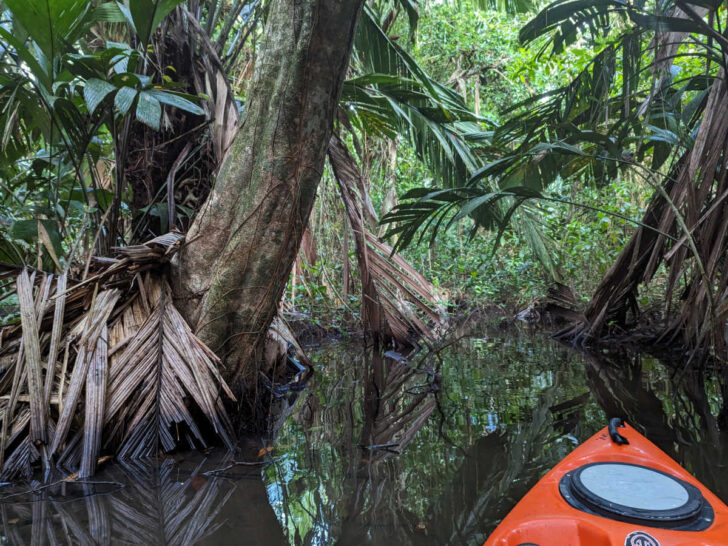
Planning a visit outside of these months? Don’t worry, between September and October, you can witness the eggs hatching.
The park’s extensive canal system is also worth exploring, with motorboat and kayak tours the best means to encounter multiple species of monkeys, sloths, and birds such as scarlet macaws and toucans.

Where to stay in Tortuguero National Park
I stayed in Mawamba Lodge , whose wooden cabins have much-needed fans and hammock-slung terraces; a swimming pool and daily wildlife spotting tours around the grounds are an added bonus. We saw scarlet macaws flying above the pool and two porcupines in a tree in the gardens.
How to get to Tortuguero National Park
The fastest way to reach Tortuguero is a domestic flight from San José to Tortuguero Airport (25 mins). Alternatively, many of the lodges will include overland transportation from San José to La Pavona (2.5 hours), from where you’ll board their boat to Tortuguero.
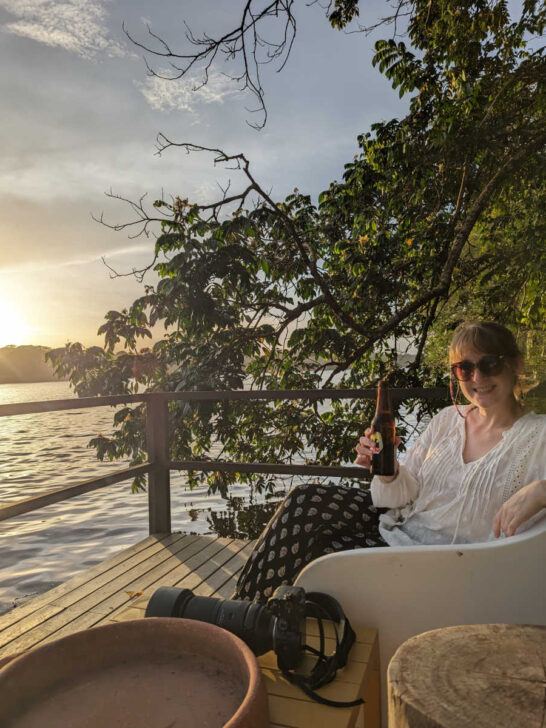
7. Laguna de Arenal
- Why it’s great for first-timers: The picturesque Arenal Lake, on whose shores lie the perfectly conical Volcán Arenal, is a pretty, low-key part of Costa Rica, where you’ll get a great introduction to the country’s volcanic background and find adventure and relaxation in spades.
The area around the regional capital, La Fortuna, is packed with activities. The most popular is hitting the hiking trails in Volcán Arenal National Park (Parque Nacional Volcán Arenal), where you’ll pass through the rugged lava flows from the volcano’s 1992 eruption.
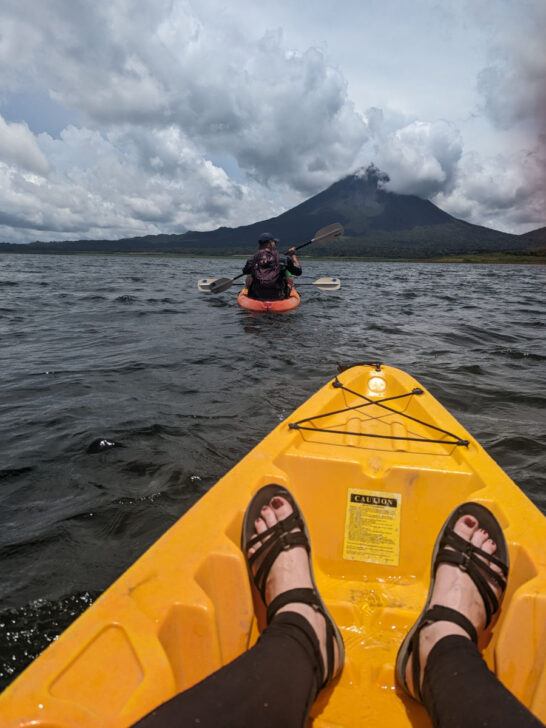
Whitewater rafting, kayaking, and ziplining are popular too. For tired limbs, the geothermal energy from the volcano (which is considered active but hasn’t erupted since 2010) has given birth to underground thermal rivers that feed mineral-rich hot springs.
You’ll find plenty in the surrounding area – many with direct views of the volcano looming in the distance.
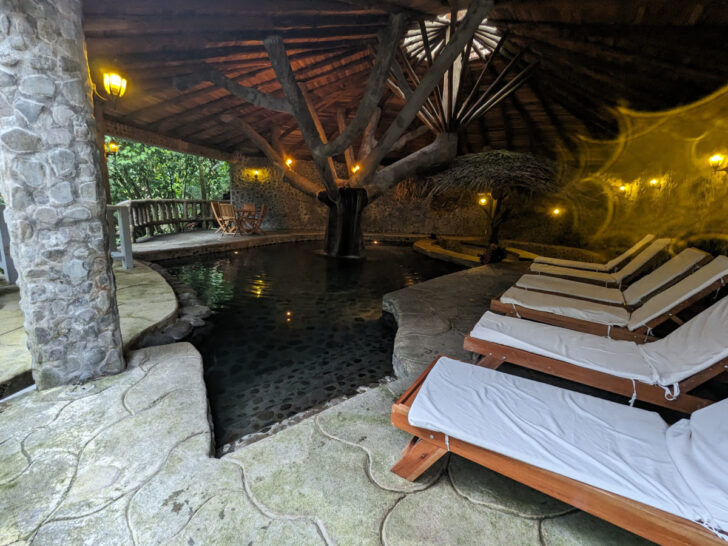
Where to stay in Laguna de Arenal
I stayed at the wonderful Rancho Margot ($335 USD double, minimum two nights, all-inclusive), a fully self-sufficient, carbon-neutral eco-resort, with cute bungalows and spring-fed swimming pools set within its extensive organic gardens. You could easily spend days here without even leaving the lodges’ grounds, with paid activities including kayaking, horseback riding, and cheese or soap-making workshops available to guests.
How to get to Laguna de Arenal
Drive or take a shuttle from San José to La Fortuna (around 3.5 hours), the gateway to Arenal.
- Why it’s great for first-timers: Nosara, situated on the Guanacaste coast, is a laid-back surf town known for its picture-perfect beaches, consistent surf, and yoga retreats. Unlike other popular surfing spots on the Pacific coast, it’s not rammed with tourists, either.
This sleepy, secluded town offers the perfect blend of active water sports and relaxation, without the same mass tourism of better-known towns such as Tamarindo further north. I found it ones of the most beautiful parts of Costa Rica that I visited on my one-month trip.
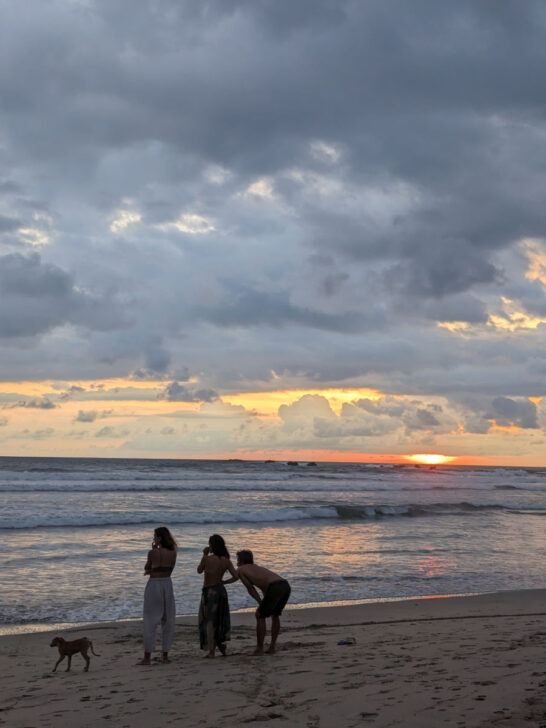
Start with a surfing class on Playa Guiones and release tired limbs with a yoga class at one of the many wellness centers in the town.
If you’re not overwhelmed by the sticky heat, go for a wander through the trails of the Nosara Biological Reserve (Reserva Biológico Nosara) on the north edge of town, where you can spot howler monkeys and even ospreys and peregrine falcons in its mangrove swamps.
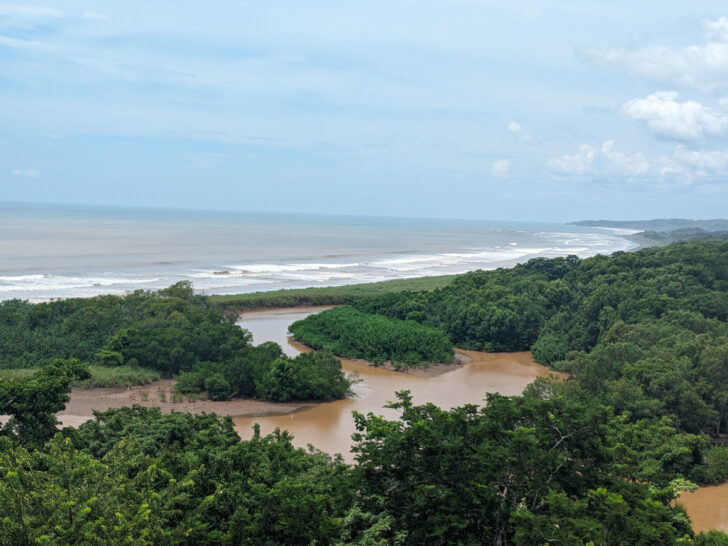
Further north, the Ostional Wildlife Refuge (Refugio Nacional de Vida Silvestre Ostional) sees the mass nesting of olive ridley turtles between July and December – although they only clamber onto the shore to lay eggs during the week before the full moon.
Where to stay in Nosara
Accommodation in Nosara is pricey, and you’ll be lucky to get a double room cheaper than $200 USD a night. I stayed at Nosara Beach Hotel ($335 USD double, which has ostentatious architecture and a prime location on the headland above both Playa Guinoes and Playa Pelada.
I found it a little overpriced, so instead would recommend Hotel Boutique Lagarta Lodge ($424 USD double), which controls access to the Nosara Biological Reserve and whose restaurant, bedrooms, and pools have pretty views across Playa Nosara .
A more affordable option is Green Sanctuary Hotel ($130 USD double), which isn’t as slick as other options, nor ocean views, but has a welcome pool and is only a ten-minute walk to the beach.
How to get to Nosara
To get here, you’ll need a high clearance vehicle (a 4WD isn’t necessary), which you can pick up from Daniel Oduber Quirós International Airport, a short flight from San José (45 mins). Alternatively, catch a shuttle from the airport, or fly directly into Nosara Airport from San José (45 mins)
9. Manuel Antonio National Park
- Why it’s great for first-timers: Situated on Costa Rica’s Pacific Coast, Manuel Antonio National Park is one of the country’s top destinations, thanks to its spectacular beaches and ample access to wildlife.
Protecting both picture-postcard beaches, mangroves, and rainforest, Manuel Antonio (Parque Nacional Manuel Antonio) packs a lot into what is Costa Rica’s smallest national park. If you’re not a big trekker, you’ll find short hiking trails here that are still a brilliant place to spot ample wildlife.
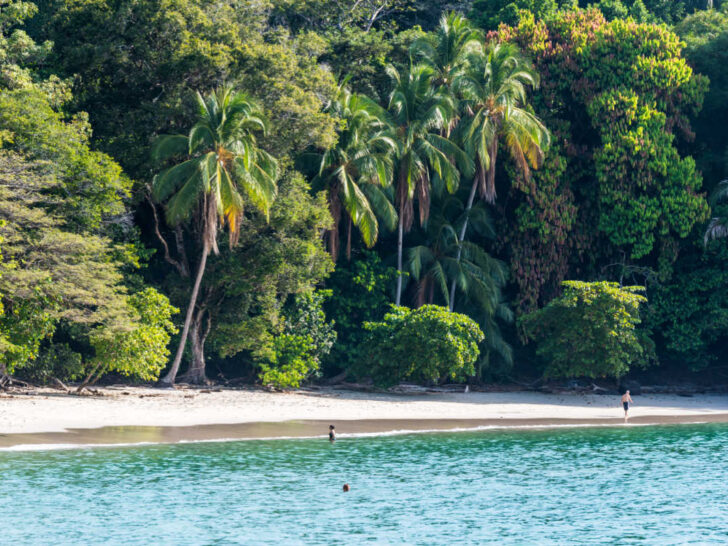
Three species of monkey – white-faced capuchin, howler, and the squirrel monkey (which is hard to see in Costa Rica) – call this protected area home, while everything from two- and three-toed sloths to agoutis, pelicans, and kingfishers are abundant here.
Visit early to avoid the crowds and ensure you’re one of the 1,200 people allowed into the park each day.
Once you’ve explored the rainforest, the park’s beautiful beaches are a good place to relax or jump in the water; beware, not all are suitable for swimming. Playa Manuel Antonio is the safest.
Where to stay for the Manuel Antonio National Park
The small town of Quepos is the best base for the park, with a selection of small boutique hotels and hostels that are significantly more affordable than those in Manuel Antonio village. If you’re looking for slick bedrooms and balconies looking out into the forest, consider the semi-affordable Hotel Plaza Yara ($200 USD double); for homespun charm, head to the family-run Casas Guaney ($90 USD double), which has extremely helpful owners and is a short drive from the town.
How to get to the Manuel Antonio National Park
Fly into Quepos La Managua Airport (30 mins) or take a shuttle or drive from San Jose (approximately 2-3 hours) to Quepos. You can reach the park by public bus or tour.
10. Volcán Poás
- Why it’s great for first-timers: One of Costa Rica’s most accessible – and active – volcanoes, Volcán Poás is an easy day trip from San José and a unique opportunity to view one of the largest volcanic craters in the world. Undoubtedly, it’s one of the coolest places in Costa Rica.
Almost continually active, Volcán Poás offers a stark landscape of ash and lava from previous eruptions. The most striking features are its three craters, two of which are filled with pretty turquoise water – although, be warned, it’s acidic and the fumes are toxic sulfurous gases.
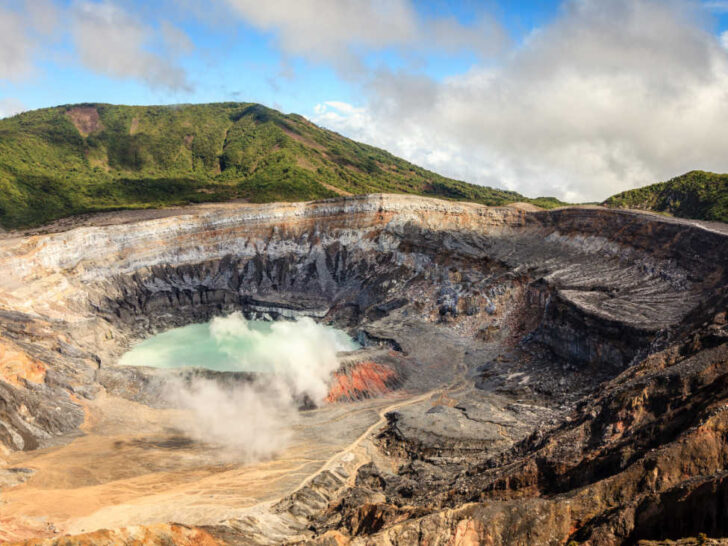
Hike to the edge of the active crater, which is bubbling and smoking, before taking on another of the short trails that wind through the cloud forest, both of which rank among the best experiences in Costa Rica.
Keep your eyes peeled for the resplendent quetzal, in all its feathery glory, and the flitting, endemic Poás volcano hummingbird.
Where to stay and how to get to the Volcán Poás
It’s best to stay in San José and take either a tour or drive up to the volcano (approximately 1.5 hours). Bear in mind you’ll need to book here in advance to arrange your visit and the park occasionally closes due to volcanic activity, so check ahead.
11. Puerto Viejo de Talamanca
- Why it’s great for first-timers: Puerto Viejo de Talamanca, a beach town on the Caribbean coast, has become a popular hangout for backpackers and surfers, thanks to its dynamic nightlife, pretty, palm-fringed beaches, and some of the best waves in the country. It also has access to an indigenous reserve, where you can learn about the Bribrí culture.
Surfing is one of Puerto Viejo de Talamanca’s biggest draws, thanks to La Salsa Brava, a beginner-friendly wave that’s at its best between December and March. More challenging swells are within reach for expert surfers.
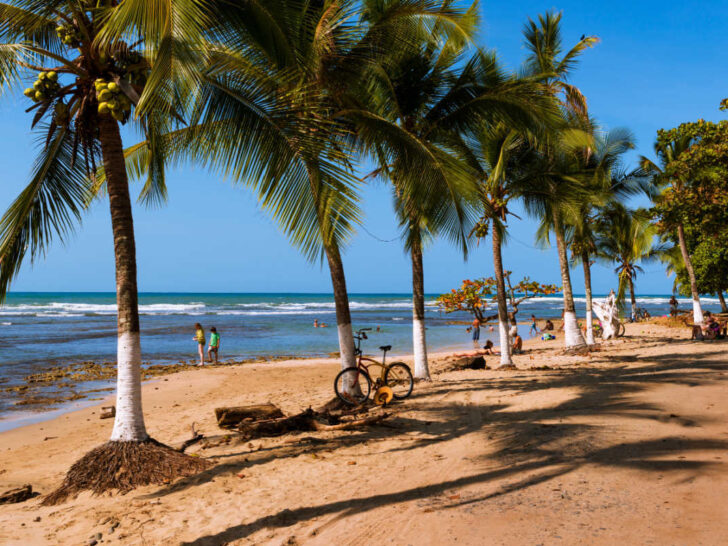
Nearby, Playa Chiquita boasts a white sand beach and is the place to kick back and relax. The clear Caribbean waters surrounding this beach are also home to colorful coral reefs and diverse marine life, making them an appealing place for a spot of snorkeling or diving.
At Punta Uva, you can also enjoy calm waters perfect for swimming. If you want a place to relax, Puerto Viejo de Talamanca is probably the best place in Costa Rica for a chilled vacation.
The town’s culinary scene is also unique, having been influenced by the Afro-Caribbean flavors of the local culture. Savor local delicacies like rice and beans, jerk chicken, and fresh seafood at the numerous beachfront restaurants, and don’t miss the chocolate, made from locally-grown cacao.
If you’re looking for culture, the nearby KéköLdi Indigenous Reserve (Reserva Indígena KéköLdi), which protects the lands of the Bribrí indigenous people, can also be visited with a local guide. As part of a tour, you’ll learn about their customs, explore the rainforest, and have a chance to buy local crafts.
Where to stay in Puerto Viejo de Talamanca
Bedrooms are spacious and it’s unusual to find a pool at this price point, but La Tica y La Gata ($86 USD double) punches above its weight when it comes to services and hospitality. It’s a short walk from the main town and the beach, ensuring a restful sleep.
How to get to Puerto Viejo de Talamanca
From San José, travelers can take a direct bus or rent a car for the approximately 4-5 hour journey to Puerto Viejo. Alternatively, a domestic flight to Limon (40 mins) followed by a 1.5-hour bus or taxi ride provides another convenient option.
12. Rincón de la Vieja National Park
- Why it’s great for first-timers: With some of the best hiking in the country, Rincón de Vieja National Park in the northwest is a protected area with brilliant infrastructure, steaming hot springs, a smoking volcano, and plenty of wildlife.
Rincón de Vieja, the park’s namesake volcano, is one of the country’s most active, and the steep, 8-kilometer (5-mile) hike up to its summit is the park’s star attraction.
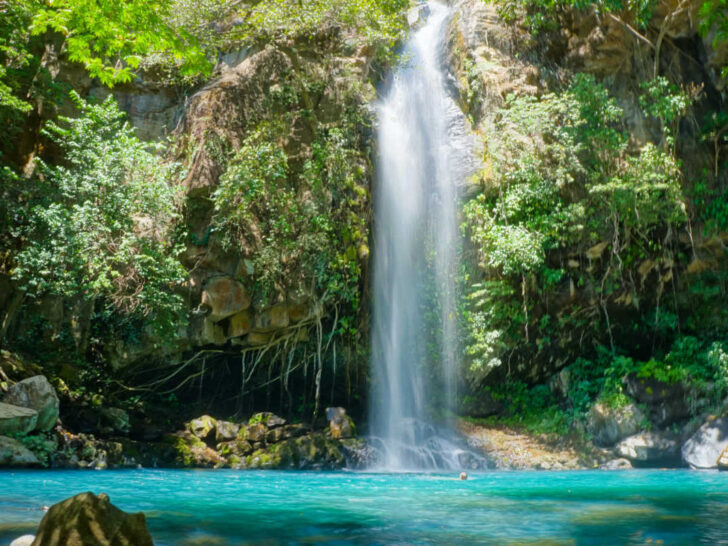
From the top, you can observe the stunning turquoise waters of the volcano’s crater lake, Lago los Jilgueros, as well as panoramas of Lago de Nicaragua across the border on a clear day.
Those preferring to go on two wheels will discover the endless mountain biking possibilities here, too.
Hot springs and the beautiful La Cangreja Waterfalls can also be visited, while nearby lodges lead horseback riding tours into some of the park’s lesser-visited areas.
Where to stay in Rincón de la Vieja National Park
Las Pailas ranger station is the best entry point into the park, so opt for a nearby lodge, such as the high-end Borinquen Mountain Resort ($243 USD double), which sits on the fringes of the volcano and has villas, a brilliant restaurant, thermal pools, and a swimming pool. Liberia has more affordable accommodations.
How to get to Rincón de la Vieja National Park
From Liberia International Airport, it’s a roughly 1.5-hour drive to Las Pailas, the entrance to Rincon de Vieja National Park. Transfers from many of the hotels in Liberia if you don’t have a hire car.
13. Santa Teresa
- Why it’s great for first-timers: Bohemian Santa Teresa might be past the days of being an overlooked little town, but it’s worth all the hype. Join the backpackers and glitzy celebrities who come to the south of the Nicoya Peninsula to surf, swim, and party.
Santa Teresa is renowned for its consistent waves, with its long sweeping beaches an ideal place for beginners to learn how to surf. Many schools offer lessons for all skill levels, with Playa Carmen the best break for newbies.
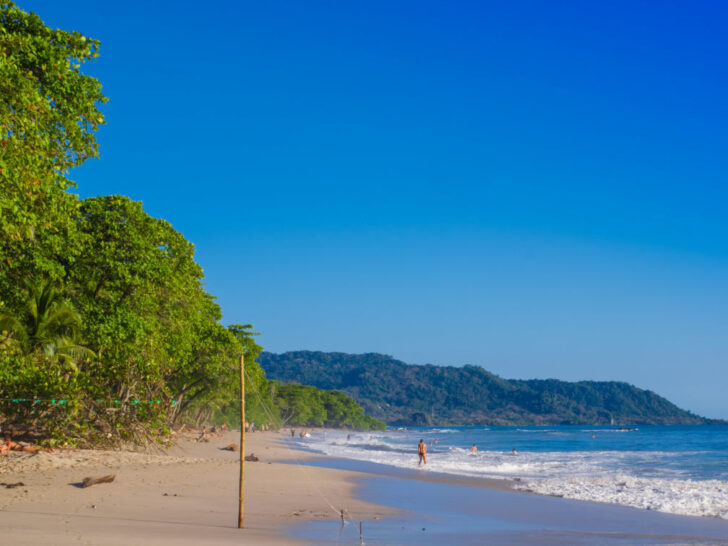
You can also join yoga classes on the beach or at one of the town’s many wellness retreats, with Santa Teresa’s serene surroundings creating the perfect environment for rejuvenation. Sunbathing, swimming, or just watching as the sun slips into the ocean at dusk are other chilled pastimes. Santa Teresa is another of the best relaxed vacation spots in Costa Rica.
Alternatively, head to Cabo Blanco Nature Reserve (Reserva Natural Absoluta Cabo Blanco), the country’s oldest protected area. This tropical forest is interspersed with trails, picturesque beaches, and plenty of wildlife, including monkeys, deer, and collared peccary.
At night, jump into the town’s acclaimed nightlife, where you’ll find international DJs and plenty of time to party.
Where to stay in Santa Teresa
There’s everything from surf camps, to hostels, and high-end luxury in Santa Teresa, meaning plenty of choice and making it one of the cheaper places to visit in Costa Rica. Only a small handful of hotels can properly call themselves beachfront, which is why Casa Cecilia ($160 USD double) is such good value for money. Rooms are a little basic but it’s far enough from the center to be peaceful and close enough for wandering in of an evening.
How to get to Santa Teresa
To get here, don’t miss the picturesque passenger and car ferry from Puntarenas on Costa Rica’s central Pacific coast to Paquera in the southern Nicoya Peninsula (70 mins). From here, head southwest by car or shuttle to Santa Teresa. Alternatively, domestic flights from San José to Tambor (30 min) followed by a short drive are another option.
14. Caño Negro National Wildlife Refug e
- Why it’s great for first-timers: Sitting right on the border with Nicaragua, Caño Negro National Wildlife Refuge is a pristine wetland teeming with biodiversity, including a staggering number of birds, making it the ultimate spot for seeing Costa Rica’s incredible endemic avian species.
Caño Negro National Wildlife Refuge (Caño Negro Refugio Nacional de Via Silvestre) is a paradise for bird watchers. The reserve is home to well over 400 migratory and resident bird species, including large storks, cormorants, and multiple types of heron, plus rarer species including the beautiful pink-hued roseate spoonbill.
Reptiles are also out in numbers, with caimans, iguanas, and swimming snakes possible to see, whether you want to or not!
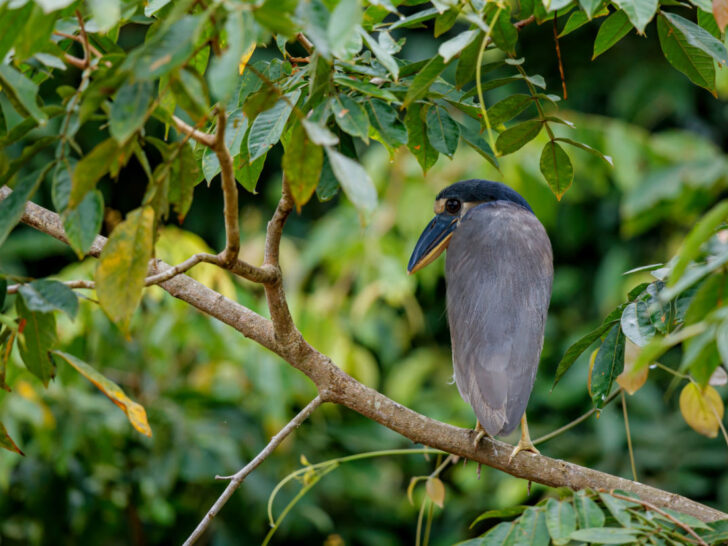
The best way to explore the refuge is with a tour, and, depending on the time of year, the experience will be vastly different.
Between December and April, you’ll be walking along the dried riverbed of the Río Frío; outside of these months, you’ll putter across the reserve by motorboat as the river floods its banks to become a 1,980-acre (3 sq-mile) lagoon.
Where to stay in Caño Negro National Wildlife Refuge
Caño Negro has some surprisingly good accommodations, including Hotel de Campo Caño Negro ($111 USD double). You can book trips directly from the hotel, which has a beautiful garden and a farm-to-table restaurant.
How to get to Caño Negro National Wildlife Refuge
The easiest way to visit the park is as part of an organized tour departing from La Fortuna, a 2.5-hour drive south of the reserve. Alternatively, you can travel by car to reach Caño Negro village or Los Chiles, both of which are gateways to Cano Negro and from where you can organize a tour.
15. Heredia
- Why it’s great for first-timers: This extension of San José’s urban sprawl promises great views of the capital from its lofty location, plus organic coffee tours and wildlife.
Most of the capital’s appeal actually lies outside of the city and basing yourself for a couple of days in the hills above is a great way to relax at the start or the end of your trip.
One of the best places to stay is Finca Santa Rosa , an organic coffee farm and family-run boutique hotel that has been pioneering sustainable and regenerative tourism in Costa Rica for over 30 years.
Their 12 hectares (30 acres) of land are cultivated according to permaculture principles and it’s well worth doing a tour of their estate followed by a coffee cupping. You’ll realize how little you ever knew about coffee!
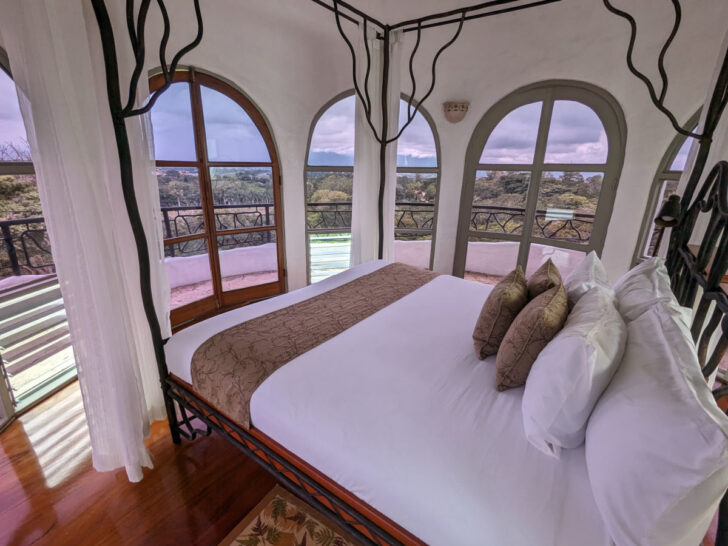
Wildlife watching is a possibility here, too. If you’re worried about not seeing some of Costa Rica’s signature wildlife, then a trip to the nearby Toucan Rescue Ranch can ensure you get up close and personal with sloths, spider monkeys, and even rare oncillas, then this is your place.
Where to stay in Heredia
While there are plenty of hotels within San José, I much preferred staying in Finca Rosa Blanca . Its whimsical architecture characterized by sweeping towers and nature-infused decor, the hotel’s 13 rooms are packed to the rafters with the owner’s artwork and all have astounding views across the capital. I stayed in the Rosa Blanca, whose bed sits in a tower with 180-degree windows, and, boy, was it worth it!
How to get to Heredia
Heredia is a short Uber right from San José, that shouldn’t cost more than around $10 USD.
Ready to start planning your trip to Latin America? Find inspiration on the best countries to visit in South America , discover the best places to visit in South America , plan your trip with seven of my favorite South America travel itineraries and head to the other end of the region, Patagonia. You can explore the best places to visit in Patagonia and uncover how to get to Patagonia .

IMAGES
VIDEO